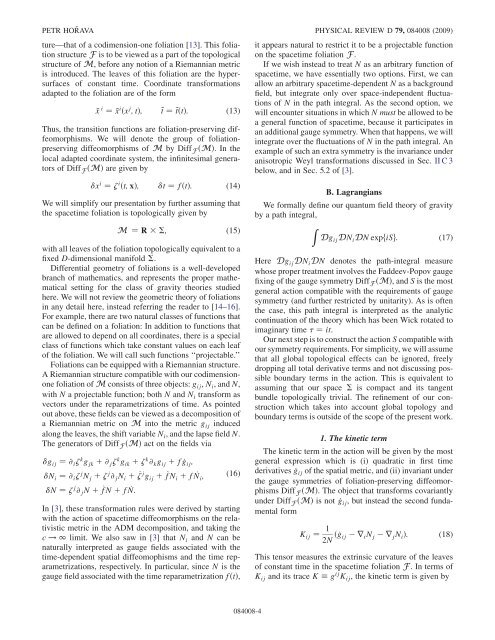Quantum gravity at a Lifshitz point
Quantum gravity at a Lifshitz point
Quantum gravity at a Lifshitz point
Create successful ePaper yourself
Turn your PDF publications into a flip-book with our unique Google optimized e-Paper software.
PETR HOŘAVA PHYSICAL REVIEW D 79, 084008 (2009)ture—th<strong>at</strong> of a codimension-one foli<strong>at</strong>ion [13]. This foli<strong>at</strong>ionstructure F is to be viewed as a part of the topologicalstructure of M, before any notion of a Riemannian metricis introduced. The leaves of this foli<strong>at</strong>ion are the hypersurfacesof constant time. Coordin<strong>at</strong>e transform<strong>at</strong>ionsadapted to the foli<strong>at</strong>ion are of the form~x i ¼ ~x i ðx j ;tÞ; ~t ¼ ~tðtÞ: (13)Thus, the transition functions are foli<strong>at</strong>ion-preserving diffeomorphisms.We will denote the group of foli<strong>at</strong>ionpreservingdiffeomorphisms of M by Diff F ðMÞ. In thelocal adapted coordin<strong>at</strong>e system, the infinitesimal gener<strong>at</strong>orsof Diff F ðMÞ are given byx i ¼ i ðt; xÞ; t ¼ fðtÞ: (14)We will simplify our present<strong>at</strong>ion by further assuming th<strong>at</strong>the spacetime foli<strong>at</strong>ion is topologically given byM ¼ R ; (15)with all leaves of the foli<strong>at</strong>ion topologically equivalent to afixed D-dimensional manifold .Differential geometry of foli<strong>at</strong>ions is a well-developedbranch of m<strong>at</strong>hem<strong>at</strong>ics, and represents the proper m<strong>at</strong>hem<strong>at</strong>icalsetting for the class of <strong>gravity</strong> theories studiedhere. We will not review the geometric theory of foli<strong>at</strong>ionsin any detail here, instead referring the reader to [14–16].For example, there are two n<strong>at</strong>ural classes of functions th<strong>at</strong>can be defined on a foli<strong>at</strong>ion: In addition to functions th<strong>at</strong>are allowed to depend on all coordin<strong>at</strong>es, there is a specialclass of functions which take constant values on each leafof the foli<strong>at</strong>ion. We will call such functions ‘‘projectable.’’Foli<strong>at</strong>ions can be equipped with a Riemannian structure.A Riemannian structure comp<strong>at</strong>ible with our codimensiononefoli<strong>at</strong>ion of M consists of three objects: g ij , N i , and N,with N a projectable function; both N and N i transform asvectors under the reparametriz<strong>at</strong>ions of time. As <strong>point</strong>edout above, these fields can be viewed as a decomposition ofa Riemannian metric on M into the metric g ij inducedalong the leaves, the shift variable N i , and the lapse field N.The gener<strong>at</strong>ors of Diff F ðMÞ act on the fields viag ij ¼ @ i k g jk þ @ j k g ik þ k @ k g ij þ f _g ij ;N i ¼ @ i j N j þ j @ j N i þ _j g ij þ fN _ i þ f N_i ;N ¼ j @ j N þ fN _ þ f N: _(16)In [3], these transform<strong>at</strong>ion rules were derived by startingwith the action of spacetime diffeomorphisms on the rel<strong>at</strong>ivisticmetric in the ADM decomposition, and taking thec !1 limit. We also saw in [3] th<strong>at</strong> N i and N can ben<strong>at</strong>urally interpreted as gauge fields associ<strong>at</strong>ed with thetime-dependent sp<strong>at</strong>ial diffeomophisms and the time reparametriz<strong>at</strong>ions,respectively. In particular, since N is thegauge field associ<strong>at</strong>ed with the time reparametriz<strong>at</strong>ion fðtÞ,it appears n<strong>at</strong>ural to restrict it to be a projectable functionon the spacetime foli<strong>at</strong>ion F .If we wish instead to tre<strong>at</strong> N as an arbitrary function ofspacetime, we have essentially two options. First, we canallow an arbitrary spacetime-dependent N as a backgroundfield, but integr<strong>at</strong>e only over space-independent fluctu<strong>at</strong>ionsof N in the p<strong>at</strong>h integral. As the second option, wewill encounter situ<strong>at</strong>ions in which N must be allowed to bea general function of spacetime, because it particip<strong>at</strong>es inan additional gauge symmetry. When th<strong>at</strong> happens, we willintegr<strong>at</strong>e over the fluctu<strong>at</strong>ions of N in the p<strong>at</strong>h integral. Anexample of such an extra symmetry is the invariance underanisotropic Weyl transform<strong>at</strong>ions discussed in Sec. II C 3below, and in Sec. 5.2 of [3].B. LagrangiansWe formally define our quantum field theory of <strong>gravity</strong>by a p<strong>at</strong>h integral,ZDgij DN i DN expfiSg: (17)Here Dg ij DN i DN denotes the p<strong>at</strong>h-integral measurewhose proper tre<strong>at</strong>ment involves the Faddeev-Popov gaugefixing of the gauge symmetry Diff F ðMÞ, and S is the mostgeneral action comp<strong>at</strong>ible with the requirements of gaugesymmetry (and further restricted by unitarity). As is oftenthe case, this p<strong>at</strong>h integral is interpreted as the analyticcontinu<strong>at</strong>ion of the theory which has been Wick rot<strong>at</strong>ed toimaginary time ¼ it.Our next step is to construct the action S comp<strong>at</strong>ible withour symmetry requirements. For simplicity, we will assumeth<strong>at</strong> all global topological effects can be ignored, freelydropping all total deriv<strong>at</strong>ive terms and not discussing possibleboundary terms in the action. This is equivalent toassuming th<strong>at</strong> our space is compact and its tangentbundle topologically trivial. The refinement of our constructionwhich takes into account global topology andboundary terms is outside of the scope of the present work.1. The kinetic termThe kinetic term in the action will be given by the mostgeneral expression which is (i) quadr<strong>at</strong>ic in first timederiv<strong>at</strong>ives _g ij of the sp<strong>at</strong>ial metric, and (ii) invariant underthe gauge symmetries of foli<strong>at</strong>ion-preserving diffeomorphismsDiff F ðMÞ. The object th<strong>at</strong> transforms covariantlyunder Diff F ðMÞ is not _g ij , but instead the second fundamentalformK ij ¼ 12N ð _g ij r i N j r j N i Þ: (18)This tensor measures the extrinsic curv<strong>at</strong>ure of the leavesof constant time in the spacetime foli<strong>at</strong>ion F . In terms ofK ij and its trace K g ij K ij , the kinetic term is given by084008-4



![arXiv:1001.0993v1 [hep-ph] 6 Jan 2010](https://img.yumpu.com/51282177/1/190x245/arxiv10010993v1-hep-ph-6-jan-2010.jpg?quality=85)


![arXiv:1008.3907v2 [astro-ph.CO] 1 Nov 2011](https://img.yumpu.com/48909562/1/190x245/arxiv10083907v2-astro-phco-1-nov-2011.jpg?quality=85)







![arXiv:1002.4928v1 [gr-qc] 26 Feb 2010](https://img.yumpu.com/41209516/1/190x245/arxiv10024928v1-gr-qc-26-feb-2010.jpg?quality=85)
![arXiv:1206.2653v1 [astro-ph.CO] 12 Jun 2012](https://img.yumpu.com/39510078/1/190x245/arxiv12062653v1-astro-phco-12-jun-2012.jpg?quality=85)
